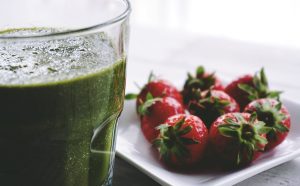Healthy eating, physical activity and a balance between work and rest are the pillars of health. However, the basis for the proper functioning of the body is healthy eating. What does the term “healthy eating” mean and why is it important to care about the quality of food?
Healthy food – what is it?
Healthy eating is providing the body with high-quality food in the amount that meets its needs. Food quality refers to:
- natural origin of food products, preferably from organic farms;
- higher bioavailability of nutrients, vitamins, minerals contained in healthy foods;
- no genetic modification of food;
- no contamination of animal products with antibiotics, veterinary chemicals and growth promoters;
- no contamination of plant products with agricultural chemicals, pesticides and heavy metals.
Healthy eating presupposes the right amount of food intake. The body’s energy needs should be balanced with the caloric content of food provided during the day. Physically active people, pregnant and breastfeeding women have a higher demand, so their menu should provide an adequate level of energy. Too low calorie diet leads to malnutrition, hormonal disorders and excessive weight loss. On the other hand, excessive energy supply causes an increase in body fat, which results in overweight and obesity.
Healthy eating also means a balanced diet. The daily menu must provide all macronutrients, i.e. wholesome proteins, fats and carbohydrates in the right proportions. The menu should also include vegetables, fruits, also in the form of smoothies, nuts (peanut butter) and seeds, which are a source of vitamins, minerals and dietary fiber.
Healthy eating for children and adults
Healthy nutrition of children, providing all the necessary nutrients during the period of growth and development of organs is a priority of pediatric dietetics. Healthy eating is crucial in the process of building acquired immunity. Food contaminated with chemicals will promote the development of food sensitivities and allergies. That is why the organic origin of food is so important for the proper development of the child, even at the stage of fetal life.
Healthy eating should be based on physiological processes in the body. Digestion and absorption of food is also a burden on the body, so it is necessary to observe not only the regularity of meals, but also 3-4 hour intervals between them. Snacking between the set times of the main meals will disturb the functioning of the hunger and satiety centers, cause fluctuations in glucose and insulin in the blood and, consequently, promote the development of obesity, insulin resistance and type 2 diabetes.
Care should be taken to provide the body with healthy food with a high biological value of protein, unsaturated fats and healthy carbohydrates. The human body has many buffering mechanisms that are designed to protect against the negative effects of harmful substances. That is why you should focus on healthy food without genetic modifications, products of organic origin from sustainable farms. Taking care of your health is also related to avoiding stimulants. Reducing alcohol consumption and smoking will minimize the oxidative processes responsible for tissue damage and aging. The body’s work will also be supported by properly selected natural dietary supplements.
Healthy eating – basic principles
Healthy food is not only about high-quality food products, but also about the right rules for eating meals, storing food products and the culinary processing used.
Principles of healthy eating
- Choose products of natural origin, from organic farms – meat, dairy, eggs, cereal products, vegetables and fruit.
- Keep your products seasonal. The shorter the product’s path from the producer to the consumer, the higher the content of nutrients, vitamins and minerals and the lower the contamination with agricultural chemicals.
- Consume products with as little processing as possible. Eating raw fruit will be more beneficial to your health than drinking juice or eating jam.
- Vegetables and fruits in a 3:1 ratio should make up half of a “healthy plate”. Variegated plants are a source of vitamins and dietary fiber.
- Dietary fibre consumed in the right amount ensures proper intestinal peristalsis, prevents constipation and helps maintain a healthy body weight.
- Healthy carbohydrates – list: groats, wholemeal pasta, oatmeal, wholemeal bread as a basic source of energy.
- Legumes, i.e. plant-based proteins m.in. chickpeas, lentils, beans, peas, broad beans, as an alternative to animal protein.
- Start your day with a nutritious breakfast, which will be a source of energy and ensure the right level of concentration. A simple solution is healthy smoothies for breakfast, gluten-free muesli or oatmeal with nuts and seeds.
- Drink about 2 liters of water a day.
Healthy eating – what to eat?
Healthy food should be varied and meals properly balanced in terms of energy and macronutrients (proteins, fats and carbohydrates).
- Healthy food and protein sources – organic meat, eggs, fish, legumes (peas, beans, chickpeas, broad beans, lentils), protein supplement. The protein you eat should provide you with all the essential amino acids.
- Proper nutrition and healthy carbohydrates – whole grain cereals, i.e. whole grain bread, groats (buckwheat, barley, quinoa, amaranth), wholemeal pasta, whole grain brown rice.
- Healthy eating and sources of fat – you should eat mainly fats of plant origin, which are a source of unsaturated fatty acids (olive oil, linseed oil, avocado). Vegetable oils are best taken raw, e.g. as an addition to salads.
- Healthy food and sources of dietary fibre – whole grain products (healthy carbohydrates), oatmeal, vegetables and fruit, preferably raw, with skin.
Healthy eating involves eliminating from the diet all substances harmful to the body, such as alcohol, smoking and others. The consumption of simple sugars should be limited, especially in refined forms, i.e. sweets, cakes, confectionery. Healthy snacks include fruit, nuts, seeds, or sugar-free oatmeal cookies.



